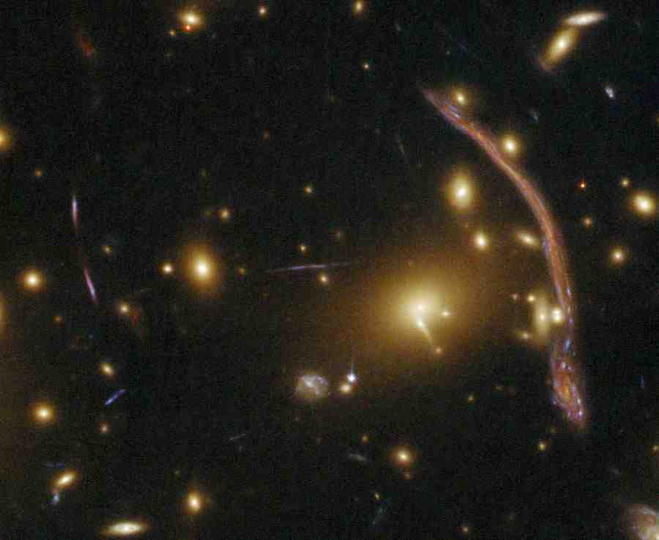geckzilla wrote:Ann wrote:No. A galaxy that contains a bright yellow bulge
Although you do have to be careful calling it yellow. I mean, if it's far enough away then blue might be something like far or mid ultraviolet while redder colors might be closer to near ultraviolet.
I must make it clear that I'm stating what I believe, not what I know. Obviously I don't
know that this galaxy contains a well-established yellow population. I just think it does. I base my belief on my very great interest in galaxies, plus the fact that I have spent a lot of time looking at galaxies and checking out their colors, general shapes, classifications and appearances.
The lensed galaxy in question looks very much like a disk galaxy to me. It very much looks like it has a bright bulge. It looks like it has spiral arms. In my experience, such galaxies have yellow centers, although there are a precious few that don't seem to follow the pattern.
NGC 4656, the Hockey Stick galaxy. Photo: Adam Block.
The best "all-blue" example I can think of is NGC 4656, the Hockey Stick galaxy. Adam Block's picture does show a faint yellowing at the center of the galaxy, but it is indeed faint.
Mark Hansen's fine picture of NGC 4656 and its blue-and-pink-and-dusty-orange neighbour NGC 4631 shows the same thing, a faint - make that
faint - yellowing at the center of the Hockey Stick. So what is the B-V of NGC 4656? Its total B-V is 0.440, which is blue but not incredible. Its effective B-V is 0.325, however, which
is extremely blue. And its apparent B-V, which takes the galaxy's external and internal reddening into account, is 0.217 according to Principal Galaxy Catalog. Such a low B-V value for a relatively large galaxy is almost impossible, and the absolutely only way for a galaxy to be so blue is if it has a very large blue population and a really faint yellow one. NGC 4656 seems to qualify.
What about the U-B of NGC 4656? Unfortunately, only the effective U-B value is given, but that is 0.320. That's a large
positive value! It suggests that NGC 4656 contains very few O-type stars at all! And what about its far infrared magnitude? NGC 4656 is fainter in far infrared than in blue light, suggesting there are low levels of starforming material in this galaxy. The Hockey Stick appears to be a dust poor, extremely blue galaxy that is hardly ultraviolet at all, one that is dominated by A- and F-type stars, with a few (late) B-type stars and a number of evolved red giants thrown in for good measure. NGC 4656 really
looks like a single generation galaxy, one that formed all its stars some 300 million years ago or so. In reality, it must contain some really old yellow stars too, and it certainly does in its bulge. (And the blade of the Hockey Stick is clearly quite ultraviolet.)
What I'm saying is that all-blue disk galaxies are extremely rare. Looking through Adam Block's galaxy images, I found another all-blue candidate:
NGC 5595, at top. This galaxy is blue both when it comes to its B-V and U-B values, but it's not
incredibly blue.
Another picture of the same galaxy pair, again with NGC 5595 at top, is rather weirdly color balanced, but at least it shows that the bulge and the arms of NGC 5595 are much the same color. But given its B-V index of 0.530, there can be no doubt that this galaxy too has an old population.
So all-blue disk galaxies are extremely rare, and therefore I doubt that the lensed galaxy in the APOD is one. The lensed galaxy is clearly old enough to have an old yellow population. It doesn't
have to have one, but I think it does.
I think that a third image of the same galaxy can be seen at 10 o'clock, right next to a smallish elliptical galaxy.
Ann



